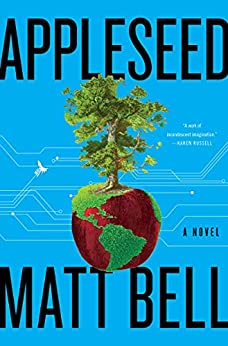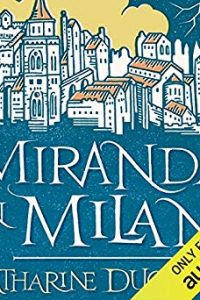Paul Di Filippo Reviews Appleseed by Matt Bell
 Appleseed, Matt Bell (Custom House 978-0063040144, 480pp, $27.99) July 2021.
Appleseed, Matt Bell (Custom House 978-0063040144, 480pp, $27.99) July 2021.
Matt Bell is a writer whose whole oeuvre (a couple of previous novels and several story collections) is plainly steeped in the elements of fantastika; a writer who is manifestly cognizant of all the hardcore tropes of the genre, able to deploy them deftly. But he is published outside the genre fences, and hailed as non-denominational Literature with a capital “L.” That’s fine, I suppose. We who came up by genre paths and still find a congenial home here should be used to this false distinction by now. Although it does still grate a bit when folks make comments like this one, uttered by Jess Walter upon the publication of Bell’s newest, Appleseed: “[He] may well have invented the pulse-pounding novel of ideas.” Oh, really? Tell it to Sturgeon, Clarke, Le Guin and a thousand others, buddy!
But none of this is Bell’s fault, and we should just be glad that such a fine book reaches us by whatever avenue. If you are in the mood for a fusion of Jim Jarmusch’s Dead Man, Rob Hart’s The Warehouse, and John Crowley’s Engine Summer, you have come to the right place. (This tasty, ultimately sui generis book has a few more flavors as well, to be mentioned later.)
Appleseed boasts a very nice interlocking tripartite structure (a bit reminiscent of David Mitchell’s techniques) whose pieces magnify and recombine with each other, and lead to an organic tale given greater heft by extension across so many years and venues. Each of the rotating sections is seen through the eyes of a different protagonist.
First off comes Chapman, resident of the still mysterious and expanding United States of America during the last years of the 1700s and the early part of the 1800s. Chapman, with his brother Nathaniel, has a mission in life: to plant apple trees across the Middle American wilderness, so that when settlers eventually arrive, they will find hospitable orchards. But Chapman is also seeking the discovery/creation of a very special tree, the Tree of Forgetting, whose fruit impart unique visions and grace.
Now, this name and scenario might ring a bell since it’s the rough outline of the Johnny Appleseed story and folklore. And indeed the parallels persist. But there’s one big difference: our Chapman is a faun. Yes, a literal Pan figure, born to a human mother, sibling to human Nathaniel. As such, he is essentially estranged from the human condition, although he shares human drives, emotions, desires, and modes of thought. We watch the generally melancholy but ever-hopeful Chapman move through decades of strange confrontations and peaceful interludes, all seasoned by his hybrid nature and governed by his quest. These passages convey a kind of postmodern-historical, Pynchonesque Mason & Dixon vibe.
Our second protagonist is a man named John Worth living in our near-future (say a decade or three hence). His America is a climate-change-wracked wasteland. Everything west of the Mississippi has been denuded and depopulated (there go all of Chapman’s orchards), and dubbed the Western Sacrifice Zone. The shell government of the USA is really just a front for the global corporation called Earthtrust, whose profiteering motives (they run factory farms staffed by indentured citizens) conceal more nefarious and megalomaniacal plans. John, a brilliant cyber-engineer, used to be a powerful figure in Earthtrust, along with the corp’s founder and current chief, a woman named Eury Mirov. But parting ways with Eury, John dedicated years to rewilding the Sacrifice Zone. However, new developments drive him back into the arms of Eury and Earthtrust, where he uncovers a massive scheme to “terraform” the whole planet underway. To aid or blockade is the question.
Lastly, we find ourselves 1,000 years after John’s time, when the whole planet is in the midst of a massive Ice Age. Our hero here is one “C,” who appears to share the faun-like nature of Chapman. C travels the glacial wastes in an automated rover home, seeking some existential answer he can hardly quantify. C also happens to be the 432nd iteration of himself. Having an embedded brain-backup failsafe module, C can be reinstantiated whenever he dies, thanks to a miraculous bio-fabricator dubbed the Loom. Like the sufferer in Tiptree’s “Painwise”, he seems to be on an endless pilgrimage for knowledge. But his quest is about to come to an end, not far from the ruins of Las Vegas, where we also tie up loose ends from the other segments.
Bell is obviously dealing with vast themes here: climate change; the abuses of power; the uses and misuses of technology; family affairs; loyalty; dreams; altruism versus selfishness; the validation of certain kind of violent protests and even terrorism. But despite these weighty issues, the book never feels tendentious or stodgy or belabored. Quite the contrary: all three modes are action-packed, with clear and vivid scenes, from a big shootout at Earthtrust HQ to quiet nights in the farm home of the Worth family, where Chapman and Nathaniel take winter refuge. And all of it is couched in elegant and poetic prose which, like the best such language, remains easy to parse and ingest while still conveying rare beauty. You could choose almost any random paragraph as example.
Chapman doesn’t hesitate. He takes his first steps on human feet, running across the Worths’ frozen yard, but before he reaches the edge of their fields he is already galloping on faunish hooves, cruising over crusted snow to jump atop their split rail fence, cracking the top rail as he leaps off it to enter the woods beyond, running over frozen logs and frigid boulders. Chilled air slides over the bark of his skin, and he laughs at the contact of hoof on solid earth, so much more satisfying than cramped shoe on sanded board. For a few hours, he thrills at his loping passage through the snowy woods, he dwells within the right feeling of his returned faun body, his inhuman footsteps never breaking the wild quiet of the cold night, the creaking of frozen trees in the stiff wind, the settling of ice, the whisper of no living thing speaking. Only once he’s exhausted does Chapman pause in the wintery dark, a faun closing his eyes to consider again the flickering blackness where this winter he’s had to hide so much of himself.
Appleseed joins the ranks of those books like Atwood’s Oryx and Crake and VanderMeer’s Hummingbird Salamander, novels which refract mankind’s eco-sins through strange lenses of grief, desire, hope, and doubts.
 While you are here, please take a moment to support Locus with a one-time or recurring donation. We rely on reader donations to keep the magazine and site going, and would like to keep the site paywall free, but WE NEED YOUR FINANCIAL SUPPORT to continue quality coverage of the science fiction and fantasy field.
While you are here, please take a moment to support Locus with a one-time or recurring donation. We rely on reader donations to keep the magazine and site going, and would like to keep the site paywall free, but WE NEED YOUR FINANCIAL SUPPORT to continue quality coverage of the science fiction and fantasy field.
©Locus Magazine. Copyrighted material may not be republished without permission of LSFF.






